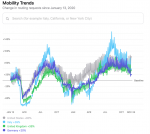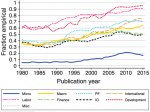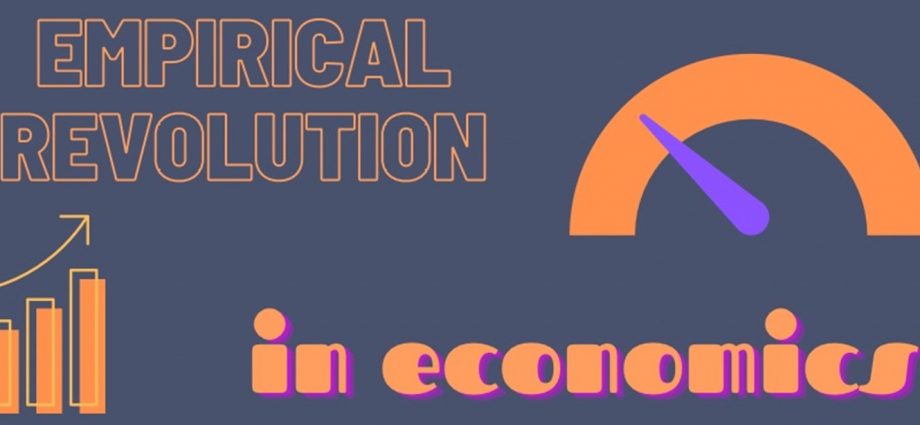Author: Derrick Cui, Graphics: Irina Sakharova
The BRB Bottomline
The field of economics is undergoing a revolution, becoming more relevant, accurate, timely and empirical by using technology to track everything, all the time.
The field of economics is undergoing a revolution, becoming more relevant, accurate, timely and empirical by using technology to track everything all the time. This is drastically changing the way policy and decisions are made that impact every single one of us. But how much privacy are individuals willing to give up to help the common good?
The Problems with Old Empirical Economics
The purpose of modern economics is to provide timely and accurate advice on the state of an economic system, whether a town, state, or country, to influence and inform decision-making (like policy). Up until now, empirical economic research has been neither timely nor entirely accurate.
First, there has been a huge time lag in economic data gathering and results (otherwise known as recognition lag). For example, the 2008 recession was only officially declared at the end of 2008, an entire year late, making that information both untimely and irrelevant. Second, it has been inaccurate because of survey methods. Up until recently, data has been collected through the sampling of a population, which is flawed because it runs into various biases, one of which being the “average treatment effect”, the bias that occurs when participants of a survey are asked for binary responses to questions where there may be infinite, making the responses biased towards discrete responses. Another bias occurs after data analysis, with the problem that the “average” response is usually never the “typical” one. This means that policies made based on the average (or even median) are representative of very few actual responses.
This is perhaps why economic research has historically been concentrated so much on theory rather than empirical work. Theory is useful because it defines general trends and integrates implied causality into decision-making. Yet, focusing too much on theory has a separate and even larger problem: it assumes that markets are perfectly competitive when none are. All markets are distorted in some sort of way, whether having non-identical products, barriers to entry, a lack of quality and price information, monopolistic behavior, irrational consumers, and much more. Theory sometimes creates more problems than it solves.
So how are economists fixing empirical research, increasing its popularity, usefulness, and timeliness? Simple: by changing the way we collect data by using technology to directly collect data from people and not rely on surveys. By constantly measuring everything, all the time, an accurate model of the current world can be quickly made, resulting in much better and more relevant conclusions of the data.
High Frequency Data
High frequency data is the solution: data continuously measured from individuals, often digitally, tracking their decisions that collectively add to data sets. With these sets, economists can create more accurate trends and conclusions that impact policy. A common example is website tracking. Websites track search history, length of page use, and frequency of ad clicks to create tailored ads.
What does this look like in the scope of economic research? COVID-19 was an unprecedented experiment that demonstrated the possible benefits of more data. In a bid to help governments limit COVID transmission, many private companies released huge anonymized (non-individually identifiable) datasets to the public. Both Apple and Google released large datasets on where people travel to and from, collected from requests to locations on Apple Maps and Location History on Google devices. These data sets contain millions of data points that are constantly updating, creating real-time information on travel that governments used to improve their COVID models and policies.

Other data points include OpenTable releasing daily counts of seated diners to gauge the economic impact of COVID on restaurants and regions, JobsEQ by Chmura aggregating new job postings, creating a strong indicator of future job and industry growth, and the Transportation Security Administration (TSA) providing Checkpoint travel numbers to indicate travel trends and the recovery of the aviation industry. Other points being collected worldwide include hour-by-hour credit-card spending, the number of supermarkets offering discounts, glasses of beer people drink daily, hotel bookings, and the number of moviegoers, all good data collectively indicating the health of specific industries. The breadth of data available is extraordinary and the points of measurement are very creative. By collecting data at multiple “transaction points,” an extremely accurate picture of an industry or economy can be made. Who knew that looking at a payroll company’s customers’ login frequency would be an accurate depiction of the labor market?
This has given economic researchers unprecedented insight into the daily habits of citizens for which trends are analyzed and policy is based upon. For the first time, economists and governments have near-instantaneous data on travel patterns, spending habits, and other empirical GDP measurements, allowing governments to form stimulus and policy decisions much more effectively.
This approach is so beneficial and popular that some public agencies offer their data publicly. New York created OpenData, a public repository of all public data, ranging from the number of Library memberships in each library to the frequency and location of food inspections. This not only provides transparency, but also lets officials, economists, and citizens improve the city by recommending changes based on statistical trends. A number of the Federal Reserve Banks also release a Weekly Economic Index based on high-frequency data which encompasses stats ranging from steel production to weekly job claims.
In response to more available data, the fraction of empirical economic research papers in top journals has significantly increased. This is not caused by empirical researchers “overtaking” more theoretical ones, but rather a subject-wide shift recognizing the quality of more empirical data analysis processes.

Impact on Policy
Governments and large economic organizations have learned to use empirical economics, revolutionizing policy. COVID was a great example of this: public fiscal stimulus internationally focused on stabilizing wages in the form of cash transfers to citizens and companies. These programs were all meant to sustain quality of life, limit poverty, and minimize unemployment. Economic analyses of these schemes’ impact were released just weeks after each round of stimulus, instead of the typical months or years because of the breadth of timely data available. This cut in time has revolutionized how policymakers use economics: it now creates timely, effective, and precise conclusions about policy. Quick conclusions praising cash transfers using high-frequency data not only allowed changes to further rounds of stimulus to improve their effectiveness but also revolutionized fiscal policy, forever changing the welfare state in its implementation by displaying the merit of giving to citizens instead of only bailing out corporations.
With evolving technology and greater access to financial services, one could imagine a future where the government can track all business indicators. If economists and governments notice a looming recession, citizens could quickly receive transfers of money, and companies with healthy balance sheets could get an injection of capital. Empirical analysis is the only way to create specialized, effective solutions to solve the world’s greatest problems. Better and more data is already used to fight inequality by measuring the impact of policy, give better loans and create better banks in developing countries so families exit the poverty cycle, and model the impact and accuracy of a carbon pricing market to increase its effectiveness in reducing emissions.
How Far Do We Go?
Many national governments (European Union, China, and the US to name a few) have proposed and begun creating digital versions of their currency using blockchain technology, the same technology cryptocurrencies are based on. This would revolutionize payments, increasing access to financial services through a free digital wallet given to all citizens and cutting transaction costs, benefiting both banks and consumers. This would also create the perfect environment to measure all individual payments in real-time. But is this too far? If economists and governments track the movement, purchase, and digital footprint of every citizen in the hopes of creating the best possible policy, is it too dystopian even if it saves lives and benefits the economy? What if governments vow to anonymize the data? Questions like these will be more prevalent in the near future as governments, private companies, and organizations push the bounds of privacy in the pursuit of bigger data and better decisions.
This piece was inspired by Jón Steinsson’s (UC Berkeley Economics Professor) article “A New Macroeconomics?” which describes the benefits of a more empirical economic research field.
Take-Home Points
- Historically, empirical economic research has been untimely and inaccurate because of the methods of data collection and time delay
- This has been solved with High Frequency Data, digital data collected from everyone that is up to date and collected instantaneously
- Data collected by governments and private companies is now quickly available to the public and researchers
- More and more papers published in top economic journals are empirical
- Policy has been positively improved as research on policy’ impact is released weeks, not months or years, after the policy
- Pushes to collect more data on individuals may cause privacy concerns even if it is anonymized and benefits everyone

